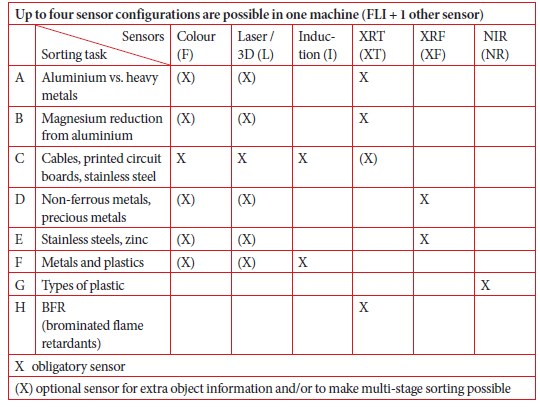In this period of extreme regulatory volatility, businesses recovering metal from automotive shredder residue need to upgrade their products depending on market conditions. In such circumstances, processors need to ensure they have a flexible sorting system.
The STEINERT KSS with the FLI XT sensor combination is ideal for small and medium-sized metal recycling businesses within a separate sorting cycle (batch). Most companies sort in several stages to yield high-end secondary raw materials.
For larger businesses, the STEINERT KSS with FLI sensor combination is the choice for improving the recovery of metal concentrates such as Zorba and Zurik. Equipped with intelligently linked multi-sensors, STEINERT KSS systems can be produced to suit the task at hand. The machine’s multi-sensors produce a multi-functionality, giving customers the flexibility to respond to sorting tasks.
Platform for various sensors
In principle, the STEINERT KSS is a platform on which various sensors can be deployed. This includes 3D detection using laser, colour and induction recognition. The system can also be fitted with a fourth sensor (near-infrared, Xray transmission or X-ray fluorescence sensor). The full list of options includes: colour detection (F), 3D laser detection (L), inductive sensor (I), X-ray transmission (XT), X-ray fluorescence (XF) and near-infrared (NR). With working widths of 1, 2 and 3 metres, the system sorts grain sizes of 10 mm and larger.
Parallel detection of objects using several sensors and signals enables very different sorting tasks to be covered with ease. Several programs can be preset in the controller and then selected via the touch panel. The STEINERT KSS is positioned in the process such that it can perform several sorting stages depending on grain size, with the concentrate (Zorba) being sorted from the eddy current separators (STEINERT EddyC) and the metal concentrate (Zurik) from the inductive sorting machines (STEINERT ISS).

Primarily X-ray transmission sensors are used to sort the Zorba fraction to remove heavy metals and heavy metal alloyed aluminium, with the overriding aim of producing a clean aluminium fraction. If a recycler also uses the machine to sort the Zurik fraction, sensors for colour, laser and induction can be added; this combination allows further sorting stages to be undertaken to produce clean cables, printed circuit boards and stainless steel products (see Table: A+C).
Magnesium significantly reduced
A specific development of X-ray transmission technology within the KSS multi-sensor structure enables the proportions of free magnesium gained from aluminium scrap and/or from the Zorba fraction to be significantly reduced (see Table: B). This enables even more efficient dry mechanical sorting of aluminium scrap to produce better purity levels.
If customers are aiming to produce individual high-grade non-ferrous metal fractions from Zorba heavy metal concentrate (copper, zinc, brass), the configuration of the KSS platform with an X-ray fluorescence sensor is recommended.
The main sorting task is to separate the Zorba fraction into its individual non-ferrous metals (see Table: D). Colour and laser sensors can also be added to use even more object features for recognition purposes and, if necessary, to respond to particular material mixes. Sensor combinations ensure that more features of the objects for sorting can be detected to achieve better selectivity and assignment. This results in even cleaner products or a greater yield.
Given the huge volume of materials involved, the sorting tasks (see Table: D+F+H) are usually undertaken by machines with individual sensors. One of the options available to small and medium-sized companies is to use the standalone solution of a machine in batch mode with an appropriate configuration. This will then benefit from the additional tasks and significantly extend the depth of sorting for smaller mass flows.
Outstanding qualities
The upgrading of various types of aluminium scrap is important in meeting rising demand from the automotive sector. Adequate recovery and sorting of aluminium profiles or scrap from end-of-life vehicles (ELV Zorba) has now become state-of-the-art for obtaining secondary aluminium such as high-quality sheet metal, Taint Tabor or cleaner cast material. Separating heavy metals from high-alloy aluminium produces excellent aluminium scrap qualities for recycling.
The STEINERT KSS FL XT has a key role to play in this recovery process as producing a good quality means guaranteed sales at healthy prices. Often, it also makes sense to use the STEINERT KSS online if, for example, aluminium scrap is to be separated from heavy metals, composites and coated proportions in a single step. A colour camera and laser sensor are then activated in addition to the main X-ray transmission sensor.
Sorting non-ferrous metals
Because of the volatile requirements placed on non-ferrous metal scrap, these metals have to be separated into various fractions (zinc, copper, brass, stainless steel, lead).
Beyond the sensory detection of metals plus 3D and colour information, the STEINERT KSS also determines the object-specific elemental composition using Xray fluorescence. Detection based on an element analysis is undertaken at great speed. The additional sensor systems increase the options available in terms of the use of secondary characteristics that can be derived from shape or colour information.
Unlike simple colour sorting, X-ray fluorescence is also capable of detecting contaminated materials, such as those covered in ash.
www.steinert.de
Don't hesitate to contact us to share your input and ideas. Subscribe to the magazine or (free) newsletter.


